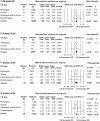Chorioamnionitis Is a Risk Factor for Intraventricular Hemorrhage in Preterm Infants: A Systematic Review and Meta-Analysis
- PMID: 30271352
- PMCID: PMC6142185
- DOI: 10.3389/fphys.2018.01253
Chorioamnionitis Is a Risk Factor for Intraventricular Hemorrhage in Preterm Infants: A Systematic Review and Meta-Analysis
Erratum in
-
Corrigendum: Chorioamnionitis Is a Risk Factor for Intraventricular Hemorrhage in Preterm Infants: A Systematic Review and Meta-Analysis.Front Physiol. 2019 Feb 15;10:102. doi: 10.3389/fphys.2019.00102. eCollection 2019. Front Physiol. 2019. PMID: 30828303 Free PMC article.
Abstract
Although chorioamnionitis (CA) is a well-known risk factor for white matter disease of prematurity, the association with intraventricular hemorrhage (IVH) is controversial and has not been yet systematically reviewed. We performed a systematic review and meta-analysis of studies exploring the association between CA and IVH. A comprehensive literature search was conducted using PubMed/MEDLINE and EMBASE, from their inception to 1 July 2017. Studies were included if they examined preterm infants and reported primary data that could be used to measure the association between exposure to CA and the presence of IVH. A random-effects model was used to calculate odds ratios (OR) and 95% confidence intervals (CI). We found 1,284 potentially relevant studies, of which 85 met the inclusion criteria (46,244 infants, 13,432 CA cases). Meta-analysis showed that CA exposure was significantly associated with all grades IVH (OR 1.88, 95% CI 1.61-2.19), with grades 1-2 IVH (OR 1.69, 95% CI 1.22-2.34), and with grades 3-4 IVH (OR 1.62, 95% CI 1.42-1.85). Both clinical and histological CA were associated with an increased risk for developing IVH in very preterm infants. In contrast, the presence of funisitis did not increase IVH risk when compared to CA in the absence of funisitis (OR 1.22, 95% CI 0.89-1.67). Further meta-analyses confirmed earlier findings that CA-exposed infants have significantly lower gestational age (GA; mean difference [MD] -1.20 weeks) and lower birth weight (BW; MD -55 g) than the infants not exposed to CA. However, meta-regression and subgroup analysis could not demonstrate an association between the lower GA and BW and the risk of IVH in the CA-exposed infants. In conclusion, our data show that CA is a risk factor for IVH, but also a risk factor for greater prematurity and more clinical instability. In contrast to other complications of prematurity, such as patent ductus arteriosus, retinopathy of prematurity, or bronchopulmonary dysplasia, the effect of CA on IVH appears to be independent of CA as causative factor for very preterm birth.
Keywords: chorioamnionitis; intraventricular hemorrhage; meta-analysis; systematic review; very preterm infant.
Figures








Similar articles
-
Chorioamnionitis as a risk factor for retinopathy of prematurity: An updated systematic review and meta-analysis.PLoS One. 2018 Oct 17;13(10):e0205838. doi: 10.1371/journal.pone.0205838. eCollection 2018. PLoS One. 2018. PMID: 30332485 Free PMC article.
-
Association of Histological and Clinical Chorioamnionitis With Neonatal Sepsis Among Preterm Infants: A Systematic Review, Meta-Analysis, and Meta-Regression.Front Immunol. 2020 Jun 5;11:972. doi: 10.3389/fimmu.2020.00972. eCollection 2020. Front Immunol. 2020. PMID: 32582153 Free PMC article.
-
Cerebellar Hemorrhage in Preterm Infants: A Meta-Analysis on Risk Factors and Neurodevelopmental Outcome.Front Physiol. 2019 Jun 25;10:800. doi: 10.3389/fphys.2019.00800. eCollection 2019. Front Physiol. 2019. PMID: 31293454 Free PMC article.
-
Association of Funisitis with Short-Term Outcomes of Prematurity: A Frequentist and Bayesian Meta-Analysis.Antioxidants (Basel). 2023 Feb 20;12(2):534. doi: 10.3390/antiox12020534. Antioxidants (Basel). 2023. PMID: 36830092 Free PMC article. Review.
-
Head midline position for preventing the occurrence or extension of germinal matrix-intraventricular haemorrhage in preterm infants.Cochrane Database Syst Rev. 2020 Jul 7;7(7):CD012362. doi: 10.1002/14651858.CD012362.pub3. Cochrane Database Syst Rev. 2020. PMID: 32639053 Free PMC article.
Cited by
-
Intrauterine exposure to chorioamnionitis and neuroanatomical alterations at term-equivalent age in preterm infants.Arch Gynecol Obstet. 2024 May;309(5):1909-1918. doi: 10.1007/s00404-023-07064-y. Epub 2023 May 13. Arch Gynecol Obstet. 2024. PMID: 37178219
-
Very Low Birth Weight Outcomes and Admission Temperature: Does Hyperthermia Matter?Children (Basel). 2022 Nov 7;9(11):1706. doi: 10.3390/children9111706. Children (Basel). 2022. PMID: 36360434 Free PMC article.
-
Three-dimensional cranial ultrasound and functional near-infrared spectroscopy for bedside monitoring of intraventricular hemorrhage in preterm neonates.Sci Rep. 2023 Mar 6;13(1):3730. doi: 10.1038/s41598-023-30743-4. Sci Rep. 2023. PMID: 36878952 Free PMC article.
-
Chorioamnionitis as a risk factor for retinopathy of prematurity: An updated systematic review and meta-analysis.PLoS One. 2018 Oct 17;13(10):e0205838. doi: 10.1371/journal.pone.0205838. eCollection 2018. PLoS One. 2018. PMID: 30332485 Free PMC article.
-
Risk factors and short-term complications of high-grade intraventricular hemorrhages in preterm neonates in training hospitals of Alborz.Iran J Child Neurol. 2021 Winter;15(1):47-55. doi: 10.22037/ijcn.v15i1.20346. Iran J Child Neurol. 2021. PMID: 33558813 Free PMC article.
References
-
- Alexander J. M., Gilstrap L. C., Cox S. M., McIntire D. M., Leveno K. J. (1998). Clinical chorioamnionitis and the prognosis for very low birth weight infants. Obstet. Gynecol. 91(5 Part 1), 725–729. - PubMed
-
- Arayici S., Kadioglu Simsek G., Oncel M. Y., Eras Z., Canpolat F. E., Oguz S. S., et al. . (2014). The effect of histological chorioamnionitis on the short-term outcome of preterm infants≤ 32 weeks: a single-center study. J. Matern. Fetal Neonatal Med. 27, 1129–1133. 10.3109/14767058.2013.850668 - DOI - PubMed
LinkOut - more resources
Full Text Sources
Miscellaneous

